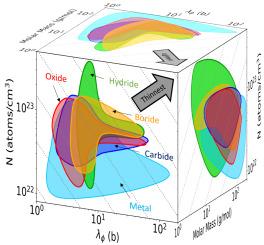用于优化辐射屏蔽的材料选择图表
IF 22
1区 材料科学
Q1 MATERIALS SCIENCE, MULTIDISCIPLINARY
引用次数: 0
摘要
材料选择图为优化工程材料的选择提供了一个客观的度量,但从未用于辐射屏蔽。在某些情况下,这可能导致次优选择,正如我们在本文中所演示的那样。我们已经重新制定了辐射传输问题,以便任何给定屏蔽方案的材料度量都可以计算,排序并映射到阿什比地图上。通过消除选择过程中的偏见,这就产生了不明显甚至违反直觉的候选材料,以供进一步研究,其性能优于传统的屏蔽材料选择,例如用于聚变反应堆的金属氢化物和用于太空快堆的硼烷。关键的新颖之处在于,这种优化考虑了辐射的类型和能谱,被屏蔽的目标的组成以及在目标中应该最小化哪种类型的相互作用。高通量方法可以对屏蔽性能随时间的变化进行研究,发现在快中子通量下,钽随着时间的推移显示出屏蔽性能的改善,这是由于182Ta的形成增加了低能量通道中中子的散射和吸收。本文章由计算机程序翻译,如有差异,请以英文原文为准。

Material selection charts for optimised radiation shielding
Material selection charts provide an objective metric to optimise the selection of engineering materials but have never been developed for radiation shielding. This can lead to sub-optimal choices in some cases, as we demonstrate in this paper. We have reformulated the radiation transport problem so that a material metric for any given shielding scenario can be computed, ranked, and mapped onto an Ashby map. By removing bias from the selection process, this has yielded non-obvious or even counter-intuitive candidates for further examination, which outperform the conventional choice of shielding materials, for example metal hydrides for fusion reactors and boranes for fast reactors in space. Key novelties are that this optimisation considers the type and energy spectrum of radiation, the composition of the target being shielded and what type of interactions should be minimised in the target. The high-throughput method, enables investigation of the shielding performance over time, finding that tantalum in a fast neutron flux, displays an improvement in shielding performance over time due to the formation 182Ta that increases the scattering and absorption of neutrons in lower energy channels.
求助全文
通过发布文献求助,成功后即可免费获取论文全文。
去求助
来源期刊

Materials Today
工程技术-材料科学:综合
CiteScore
36.30
自引率
1.20%
发文量
237
审稿时长
23 days
期刊介绍:
Materials Today is the leading journal in the Materials Today family, focusing on the latest and most impactful work in the materials science community. With a reputation for excellence in news and reviews, the journal has now expanded its coverage to include original research and aims to be at the forefront of the field.
We welcome comprehensive articles, short communications, and review articles from established leaders in the rapidly evolving fields of materials science and related disciplines. We strive to provide authors with rigorous peer review, fast publication, and maximum exposure for their work. While we only accept the most significant manuscripts, our speedy evaluation process ensures that there are no unnecessary publication delays.
 求助内容:
求助内容: 应助结果提醒方式:
应助结果提醒方式:


